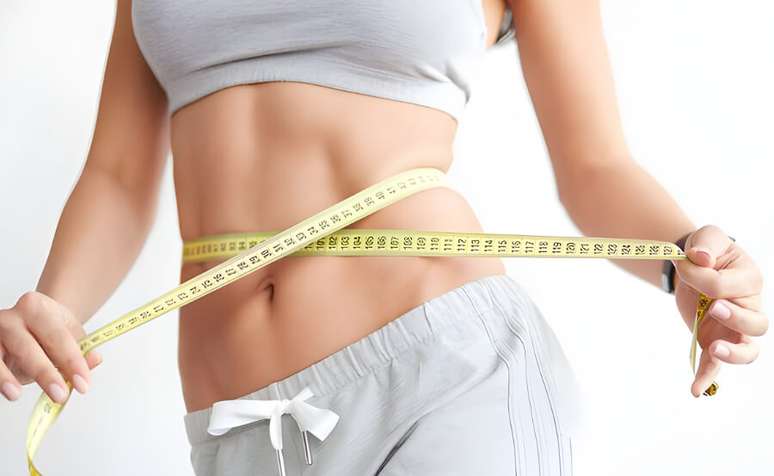Areas such as arms, hips, hips and thighs tend to have more stubborn and difficult-to-burn fat.
Ah, localized fat. If there’s anything that’s more persistent than dieting and focusing on the gym, it’s definitely that stubborn fat that accumulates in certain regions. Resistant to diet and exercise, they generally accumulate in multiple locations, such as the arms, hips, thighs, hips and even the back, showing genetic and hormonal patterns.
“Despite offering fewer health risks than visceral fat, which has a metabolic and hormonal behavior capable of increasing the body’s inflammatory profile, reducing insulin sensitivity and increasing blood pressure, localized or subcutaneous fat is more difficult to burn because it is colder fat, presenting fat cells with fewer mitochondria and, consequently, with less energy and greater difficulty in burning fatty acids. Furthermore, localized fat has a genetic factor, which also makes it more difficult to eliminate,” explains nutritionist Marcella Garcez, director and professor of the Brazilian Association of Nutrology (ABRAN).
“They are resistant, because the body uses this fat as an energy source only as a last option,” adds Cláudia Merlo, Doctor of Cosmetology at the BWS Institute.
Accumulation is different in men and women
First of all, there is already a difference regarding gender. “Fat accumulation in women and men is very different and there are several factors that explain this difference. They accumulate more fat between the legs and in the buttocks and hips region while they tend to have more in the abdominal region and hips. What justifies this accumulation is the difference in each person’s lifestyle, hormones and genetics, which are sovereign,” says Deborah Beranger, endocrinologist, with a specialization in Endocrinology and Metabology at the Santa Casa de Misericórdia do Rio de Janeiro . Janeiro (SCMRJ) and her postgraduate diploma in Intensive Care at the Faculdade Redentor / AMIB.
Hormonal imbalance can make areas of fat accumulation look a little messy.
“Men with less testosterone have more fat in the chest, chest and arm region. This type of biotype corresponds to men who produce less testosterone due to fat. As you lose weight, this testosterone will regulate and the fat located in the breasts will decrease,” says Deborah.
“People who have high insulin (insulin resistance) tend to accumulate fat more in the shoulder and hip region. Those who have high cortisol, a very stressful life, a lot of rush and little sleep tend to accumulate fat in the abdomen, with a greater risk of heart attack and stroke,” says the endocrinologist.
“Women who have high estrogen levels tend to have more fat on their hips. This is why, during menopause, when a woman reduces estrogen production, she no longer has the accumulation on her hips and begins to have accumulation in her body similar to that of men, who tend to accumulate more in the abdomen due to lack of estrogen. ”, explains Debora.
Food and exercise can help
Of course, with proper monitoring, diet and exercise can also help reduce localized fat in certain areas. Some specific foods can even help speed up this process, such as thermogenic foods, which include bell peppers, ginger, cinnamon, coffee, and green tea.
“This is because these foods discreetly increase thermogenesis, speeding up the metabolism and improving the digestive process. But we cannot delude ourselves that these foods “melt” fat, because this does not happen. Localized fat loss occurs through weight loss in a caloric deficit, that is, by eating fewer calories than you consume,” explains Marcella.
According to Deborah, exercise and good habits also help improve hormonal balance.
“Those who consume more alcohol, smoke and follow a high-fat diet also tend to accumulate more abdominal fat. The more exercise you do, such as resistance exercises to build muscle (bodybuilding), which make you burn more calories, the more abdominal fat you lose. During intense exercise, GH, growth hormone, is released, which helps us burn fat. There is also a release of adrenaline, which generates vigor and energy. These hormonal releases are important to be able to perform the exercise with will and to enjoy its benefits,” says the doctor.
“But we must also improve our lifestyle and diet quality, reduce alcohol and fat consumption, avoid smoking and processed and ultra-processed foods, increase physical activity and take care of our sleep pattern. The worse the quality of sleep, the greater the risk of insulin resistance. Insomnia also increases adrenaline and cortisol, which in turn increases stress. Furthermore, it increases the hormones responsible for stimulating the hunger center, generating binges that lead to greater fat accumulation and overweight,” says Deborah.
“Reducing our stress level also helps; try meditations, improve your working relationship and include free time activities,” adds the endocrinologist.
Application of reducing substances
There are also safe options to perform in medical clinics. According to Cláudia Merlo, the application of substances that reduce fat cells is a good option.
“I like the results on the flanks. It is a region where the fat density is high, so more than one session may be necessary, up to three or four depending on the case,” adds the doctor.
The treatment consists of the subcutaneous application (into the fat layer) of drugs that cause the degradation of the fat molecule.
“They also cause an inflammatory process. At the time of application the patient does not feel pain, the use of anesthesia or ointments is not necessary. But with the inflammation generated, pain appears from the first day, along with symptoms of heat, redness and swelling at the point of application”, underlines Cláudia Merlo. “The regions where patients report the highest level of pain are the arms and back. But after a day you feel pain just touching the treated area.”
Cláudia also recommends the Hifem+ technique with EmSculpt Neo technology, a non-invasive body contouring device, which works with fat burning and muscle hypertrophy benefits through the treatment.
“Emsculpt Neo technology emits synchronized radio frequency simultaneously with the muscle stimulation of HIFEM technology (high intensity focused electromagnetic field), responsible for the reduction of fat cells. The result of this union of two energies results in greater fat burning and greater muscle growth than any other procedure, all faster and less expensive. Hifem+ technology contracts muscle fibers at intensities that are not achievable during voluntary physical exercise,” explains Cláudia Merlo.
Clinical studies show, on average, a 30% reduction in subcutaneous fat. To improve the redesign of the body it is also possible to opt for liposuction.
“In short, liposuction removes excess localized fat, aiming to improve the contour of the body. This procedure is performed using an instrument called a cannula, which is connected to a suction device so that the fat can be sucked out. However, the technique can be performed in different ways,” summarizes plastic surgeon Tácito Ferreira, member of the Brazilian Society of Plastic Surgery and specialist in advanced body techniques at the Institution Body Contouring Academy & Faculty of Medicine of Santos.
“And with the addition of recent techniques, we can highlight the muscles of the body, making the body more athletic and even hypertrophy them,” he adds. This is possible with the UGraft technique which, in addition to suctioning the fat that visually prevents the definition of the six pack, also promotes muscle hypertrophy through fat grafting, rich in stem cells.
“The UGraft technique complements and improves the high definition technique; Even patients who do not have very developed muscles can now obtain a more natural aesthetic result,” explains the doctor. “Always seek a doctor for the best recommendation,” concludes the specialist.
inspires transformation in the world of work, in business, in society. Compasso, a content and connection agency, is born.
Source: Terra
Ben Stock is a lifestyle journalist and author at Gossipify. He writes about topics such as health, wellness, travel, food and home decor. He provides practical advice and inspiration to improve well-being, keeps readers up to date with latest lifestyle news and trends, known for his engaging writing style, in-depth analysis and unique perspectives.









